While not among the top choices of online punters, boxing is still a sport that is preferred by many virtual bettors. One of the reasons why boxing may not be that popular is the lack of regular events played every week or every day. That said, boxing is a thrilling sport with numerous fans across the globe, making it a great betting option for placing wagers online.
One thing that attracts a huge amount of attention to boxing betting is the fact that fans are always waiting for one major event. Usually, bets are collected months before the event, with numerous punters staking huge amounts of money. With many boxing fighters having a huge following online, bettors from all around the world flock to online sportsbooks to support their favorite boxer and hopefully cash in on his/her win.
Super-fights are one of the main reasons why boxing is commonly covered by both land-based and online sportsbooks. Even before the legalization of sports betting on the US market, boxing matches such as Mayweather vs McGregor brought Vegas casinos millions of dollars, generated by numerous fans of the sport and the two major boxing stars.
After the revocation of PASPA in 2018, numerous states have legalized sports betting or are currently working towards launching sports betting in the future. Add super-fights to the equation and you will get the guaranteed popularity of boxing among punters for many more years to come.
If you are interested in boxing betting and want to learn more about the successful way to make boxing wagers, we recommend that you keep on reading the detailed guide we have provided below.
Understanding Weight Classes in Boxing
To be able to construct the right strategy for your boxing betting experience, you must be fully aware of the specific elements in this sport. Weight classes are very important in boxing, with every fighter weighing in himself/herself before the fight. Even fighters that classify as heavyweight boxers, having no limit for their weight, go through the weigh-in process.
There are a total of 17 weight classes in boxing, starting from fighters weighing 105lbs, going all the way up to 200lbs and heavier. Different weight classes ensure fighters of all sizes have a fair chance to compete in professional boxing fights, against competitors who are in the same weight class. Back in the day, there were only eight divisions but nine additional classifications expanded the weight classes in professional boxing.
Strawweight
The first division is strawweight, also known as mini flyweight or minimumweight. The weight limit for this class is 150 lbs and it is one of the newest classifications in boxing. Thanks to different sanction bodies, this division was introduced in the years between 1987 and 1990. The first time the strawweight class was introduced was in the 1968 Olympic Games, going by the name of Light Flyweight class. In 1997, the new division was finally recognized by Ring Magazine.

Junior Flyweight
The next division is Junior Flyweight, also referred to as Light Flyweight or Super Strawweight. The weight limit for fighters in this division is 108lbs. This classification was introduced back in 1920 when boxing was legalized but in 1929, the New York State Athletic Commission withdrew the weight class. It was not until the 1970s, that the division was reintroduced by the WBC and other bodies. The first championship in this weight class was won in 1975.
Flyweight
The next division in professional boxing is Flyweight and it is reserved for fighters with a weight limit of 112lbs. This is the last of eight traditional divisions in professional boxing. The first championship win in this weight category was in 1911, with the winner being crowned by the British Boxing Board of Control.

Junior Bantamweight
Unlike Flyweight which is one of the standard divisions, Junior Bantamweight is one of the newer weight classes. The weight limit for fighters who fall under this category is 115lbs. The first title fight for this division was held by WBC in 1980. This new class was introduced to offer fighters who fall under the gap between Bantamweight and Flyweight more chances for competing in professional boxing matches.
Bantamweight
To compete in this division, fighters must weigh between 115lbs and 118lbs. The first Bantamweight fight was held in 1889, but back then the weight limit was 110lbs. The current weight limit for this division in professional boxing was updated in 1910.

Junior Featherweight
The next weight class in professional boxing is Junior Featherweight, also known as Super Bantamweight. This is more like an in-between division, with the weight limit being 122lbs. The limit for this class was first approved by the New York Walker Law in the 1920s. The division for fighters between Bantamweight and Featherweight was recognized by other big boxing bodies in 1976.
Featherweight
The next boxing weight class is known as Featherweight and the limit for that division is 126lbs. Originally the weight limit for this division in the US was 114lbs. With time, the limit for fighters competing in this division moved up, remaining fixed at 126lbs ever since 1920.

Junior Lightweight
Another weight class in professional boxing is Junior Lightweight, also referred to as Super Featherweight. The weight limit for the fighters who compete in this division is 130lbs. This category was introduced in 1920 when the New York Walker Law was passed. Later, in 1930, the division was also recognized by the New York State Athletic Commission. The first champion in the Junior Lightweight class was crowned in 1914. This division was suspended in 1933 but was later brought back in 1960.
Lightweight
The next weight class in boxing is Lightweight, with the weight limit being 135lbs. This is one of the eight standard divisions of the sport. In the 1904 Olympics, American fighter Harry Spanger won the first championship for the division. One of the greatest boxers of all time, Benny Leonard, holds the record for the fighter carrying the Lightweight championship title for the longest period – over 7 years.
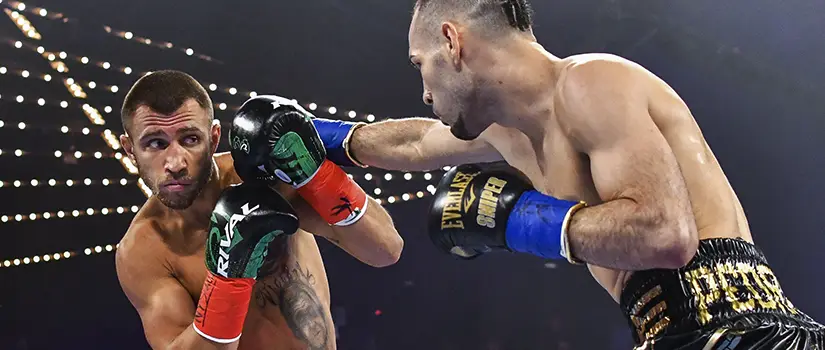
Junior Welterweight
The next weight class in boxing is Junior Welterweight also known as Super Lightweight or Light Welterweight. The weight limit for this division is 140lbs and the first championship in this division was won by Pinky Mitchell in 1946. Despite the championship being awarded by Boxing Blade magazine, in 1930, the New York State Athletic Commission stopped recognizing the weight classification. In 1935, it was also suspended by the National Boxing Association. The division was recognized again in 1959 after Carlos Ortiz won the title in the Junior Welterweight class.
Welterweight
The class for fighters weighing up to 147lbs is known as Welterweight. It serves as an in-between class between Lightweight and Middleweight. One of the most prominent names in professional boxing, Felix Trinidad held the title for the champion in this division for 6 years, 8 months and 14 days. This period marks the longest-reigning champion of the Welterweight division.
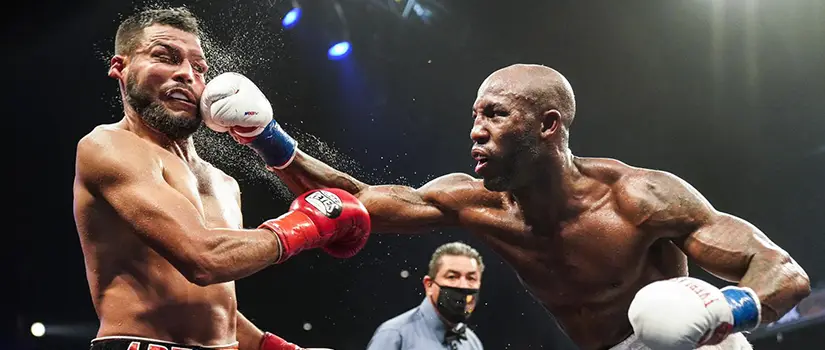
Junior Middleweight
In 1962, the Junior Middleweight division was introduced in 1962 by the Austrian Board of Control in a boxing match between Teddy Wright and Emile Griffith. After 15 rounds, Griffith ended up as a winner of the fight. This put the start of the WBA championship and the WBC also starting its own championship in 1975. In 1984, the IBF followed with its own Junior Middleweight championship and so did the WBO in 1988. Many all-time boxing stars like Floyd Mayweather, Manny Pacquiao, Oscar De La Hoya, and Sugar Ray Leonard belong to this division.
Middleweight
One of the first and oldest divisions in professional boxing is Middleweight. The weight limit for this class is 160lbs and it is believed it was first recognized in the 1840s. There are records for some of the first fights in this division to have been played back in 1867. In 1904, Charles Mayer became the first champion of the Middleweight class.

Super Middleweight
The next weight class in professional boxing is Super Middleweight, with the weight limit for boxers in this division being 168lbs. This class was created from the Junior Light Heavyweight category which was reserved for boxers up to 167lbs. This is an in-between division dedicated to fighters that fit neither the Middleweight nor the Light Heavyweight classes.
Light Heavyweight
The next class is the Light Heavyweight and it is dedicated to fighters who fit the weight limit up to 175lbs. This division has a prominent number of champions, many of whom have advanced to the full Heavyweight division in professional boxing. One of the biggest stars of this division is Bernand Hopkins who has been competing in professional fights for several decades. Other popular names from the Light Heavyweight division include Evander Holyfield, Ezzard Charles, Floyd Patterson, Michael Spinks, and Roy Jones Jr.
Cruiserweight
Dedicated to the fighters who fit the weight limit of up to 200lbs, the Cruiserweight is the next class in professional boxing. This division is also known as Junior Heavyweights, with the original limit being capped at 190lbs. The first major body that recognized the class in 1979 was the WBC. It allowed smaller heavyweight fighters to participate in more advanced matches rather than competing in the Light Heavyweight division. Some popular boxers from the Cruiserweight class that have moved up to the Heavyweight league include Evander Holyfield and Oleksandr Usyk.

Bridgerweight
The newest division in professional boxing is Bridgerweight, with fighters in this class weighing between 200lbs and 224lbs. This class was introduced in 2020 by the WBC but it still has not received the recognition of other major boxing bodies.
Heavyweight
The last division in professional boxing is Heavyweight, with no limit for the weight of fighters. That said, the lower limit to qualify for this division has been moving upwards throughout the years. Back in the day, fighters weighing 170lbs or more were considered Heavyweight boxers. However, as professional fighters tend to grow taller and bigger throughout the years, the lower threshold for the division began to rise up. With the introduction of the Cruiserweight class in the 1970s and 1980s, only fighters who weighed more than 190lbs were considered heavyweight. The threshold then became 195lbs until it reached 200lbs. Currently, the heaviest fighter in this division is Nikolay Valuev who weighed 324lbs in his 2005 fight against John Ruiz.
Types of Wagers to Make When Betting on Boxing
Unlike other sports, boxing does not offer that many bet types but it most certainly provides great options like futures, props, and the standard moneyline bet. Before you jump headfirst into boxing betting online, we recommend you to shop betlines and compare the odds at several trustworthy sportsbooks. This will allow you to pick the betting operator that offers the best value for your bets.
Moneyline Bets
Probably the easiest and most widespread bet type in boxing betting is moneyline. If you lack experience in sports betting, you can start your journey by placing moneyline bets. That said, moneyline is not a bet variation only preferred by inexperienced bettors. In fact, many professional punters stick to moneyline boxing betting, relying on huge success if they predict the outright match winner.
Simply put, making a moneyline boxing bet will enable you to place your money on the fighter you believe will win the match. Instead of having only two options for your moneyline bet, however, you will also have the chance to place your money on Draw instead of betting on either of the fighters. This is the option you can choose when you believe the match will end in a tie. That sort of outcome, however, is very rare for boxing, which is why most punters place their stakes on the boxer they believe will be the winner of the fight.
The easiest way to understand moneyline boxing betting is to take for example the super-fight between Mayweather and McGregor, or any other two fighters. In every match, we have one of the fighters as the favorite and the other one as the underdog. If we use the American odds format, we will have the odds for the favorite expressed in a negative number, while the odds with a plus sign will correspond to the underdog of the fight.
In the example with the super-fight, if we consider Mayweather the favorite, we might see odds of -250 or something similar. Meanwhile, McGregor who will be the underdog in our example may have odds similar to +150. By looking at these odds, you can determine that to win $100 by placing your wager in Mayweather, you will need to stake $250. Meanwhile, the underdog odds express that a $100 stake on McGregor can win you $150.
If you are struggling to understand odds, you can try to remember that positive odds indicate your potential win for a $100 stake, while negative odds show the amount you need to bet to win $100. As mentioned before, a tie in a boxing match is a rare outcome which is why the odds on Draw may often be +3000 or even higher. In this case, a $1,000 stake on Draw will bring you a win of $3,000 if the result of the match is a tie. Of course, you do not have to go for wagers as big as $100, but that amount is used to give you an idea of your potential profit.
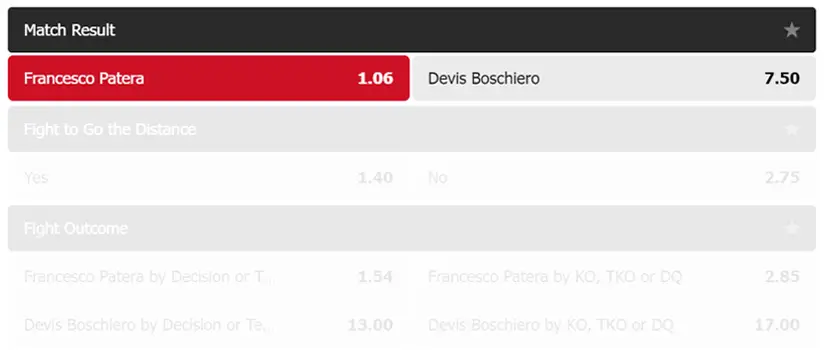
Method of Victory
Another very popular bet type you will find at boxing sections of sportsbooks is Method of Victory. If you want to try something less conventional and add some spice to your boxing betting, you can try this type of bet. As the name of the wager suggests, punters are placing their money on the method they believe will bring the winner the desired outcome.
There are several methods of victory in boxing, with all of them typically represented in this type of bet. You can decide to bet on one of the fighters winning via a knockout (KO). If you are a fan of the sport, you most certainly know that when a fighter is knocked down and cannot stand up before the referee’s countdown is over, the fight is won via a knockout.
There is also a technical knockout (TKO) which is the result of the fighter being knocked down and getting up before the end of the countdown but the referee still ending the fight as he believes it is not safe to continue the match. It is also possible for one of the fighters to go back to his/her corner and refuse to return to the fight for the next round. This type of result is known as a retired opponent (RTD) and can also be seen among the bet markets for the Method of Win bet type.
Another method to win the match is through a unanimous (UD), split (SD), or majority decision (MD). As the name of the method suggests, whenever the result of the match is decided based on the points they receive after all rounds, a unanimous decision is achieved when all three judges agree on the same winner of the match. When two of the judges pick one fighter as the winner and the third judge decides it is a tie, the match is won via a split decision. Meanwhile, if the third judge picks the opponent as a winner, the match is won via a majority decision. A boxing fight can also be won via a technical decision (TD). This is the outcome of a fight being forcefully stopped due to a serious injury and it is up to the judges to decide the winner of the match.
If you want to make a Method of Victory bet, you can also bet on one of the fighters winning after his/her opponent has been disqualified (DQ). While there are different reasons for a fighter to be disqualified, this is mainly the case when there are way too many fouls and violations of rules.
If we take for example the match between Mayweather and McGregor from earlier, we might have Mayweather as the favored winner with odds of -250. A Method of Win bet may also favor Mayweather beating his opponent via a KO, with odds being +150. If Mayweather indeed beats McGregor by knocking him out, both of the bets will pay out. Bettors who are confident in the fighter they support may even parlay moneyline and Method of Victory bets and combine the odds for even more generous wins.
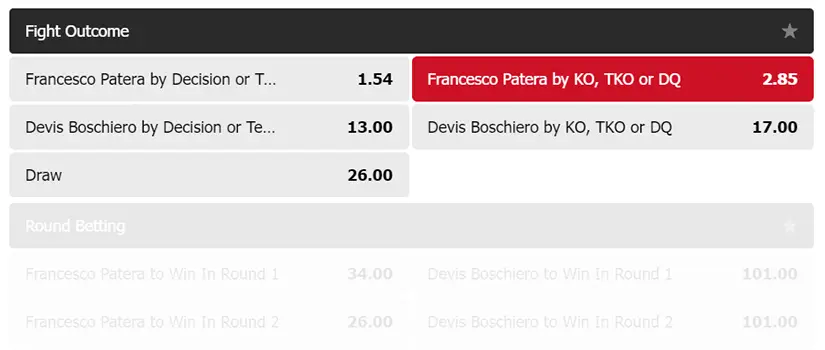
Total Rounds
As you may have guessed, this is a totals bet that can be placed on boxing events. This type of bet is also often referred to as Over/Under as bettors make wagers on either a certain result exceeding or staying below a predetermined value. In the case of boxing betting, you may often have the option to bet on the number of rounds that will be played before the winner of the match is announced.
If you see a betline of 11.0, this indicates a total of 11 rounds. If you think that the winner of the match will be determined in fewer rounds, you make an Under bet. If you decide to make an Over bet, this would mean that you believe the match will last more than 11 rounds. In the instance of the match lasting exactly 11 rounds, the bet ends up a push and you receive your stake back.
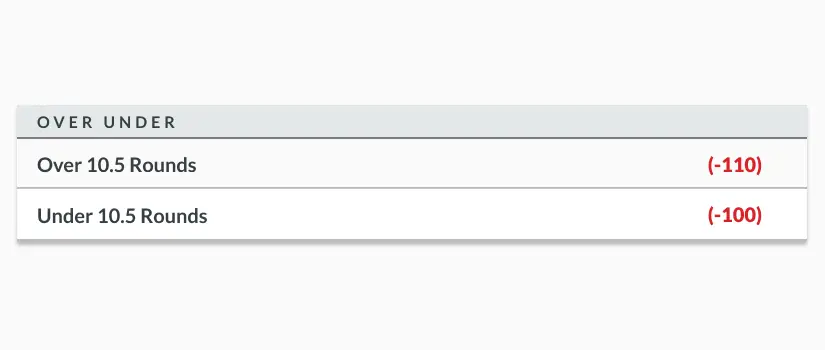
Round Betting
While it sounds similar to Total of Rounds, the two types of bets should not be mixed up. One way to make your boxing betting experience more riveting is to resort to the so-called round betting. This option enables you to place a moneyline bet on every new round. This means that the odds presented are for the winner of the specific round and not the entire match. This type of wager is typically available at sportsbooks that support in-play bets.
If you want to raise the thrill level and hopefully stack up bigger payouts, you can make a new wager on every round and hopefully enjoy plenty of successful consecutive bets. Even if you have a favorite for the match, you can still pick the opponent for some of the rounds if you believe there is a chance for the competitor to show a strong performance in any specific round. This is typically a type of bet that is preferred by pros who are capable of analyzing the winning potential of both fighters throughout the different stages of the fight.
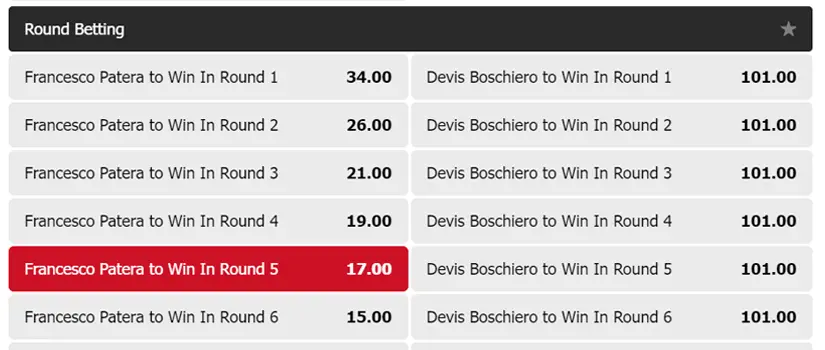
On-Points Betting
Similar to the point spread bet type that can be found with other sports covered by betting platforms, boxing often offers on-points betting. Professional boxing matches judge fighters on a scale of a total of 10 points. In most cases, rounds end with a result of 10-9, with the stronger fighter receiving more points for the respective round.
Every time a fighter gets knocked down, a point is reduced from his/her score. If the round is considered a tie, both boxers receive 10 points for the round. In case of both boxers being knocked down, their points are being recalculated accordingly as the two KOs cancel each other out.
Whenever a fighter makes a foul intentionally, points are being removed from his/her score. That said, unintentional fouls may also lead to point reduction. Making an on-point bet will allow you to guess the potential champion and the difference in scores between the winner and the losing opponent.
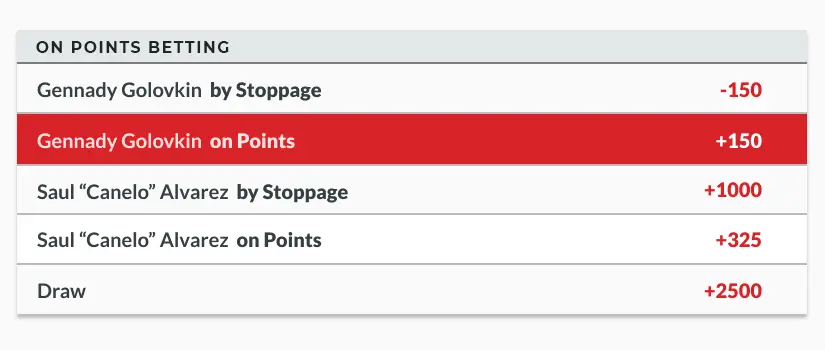
Boxing Betting Strategies to Apply to Different Boxing Bets
As mentioned earlier, there are different betting types you can make use of when you want to place wagers on professional boxing fights. For every betting variation, there are different tips and tricks you can utilize to elevate your betting experience.
One very important thing to keep in mind when you want to engage in this type of betting is to find value in odds. If we take for example the fight with a total of 11.0 rounds, you will need to guess correctly if the match will last longer or it will finish in fewer rounds. There are several tips you can follow to properly determine the way you should form your Over/Under bet.
One factor to consider while you are considering the fight is to pay close attention to the health condition of fighters. Major professional boxers who return from injury are typically trying to stay in the fight for a longer time as this will help them with their cardio. If you know that one of the boxers is returning from injury, you can often go for the Over bet type if the totals are somewhere around 5.5 rounds. This is especially true if you know that one of the fighters is often known for corner stoppage.
It is also important to keep in mind if a fighter is competing after he/she has been recently defeated by KO. This can affect a boxer’s durability and the fight you bet on may not last that many rounds. If a fighter has a long record of continuous KOs, this can also be a huge indicator for the fight lasting fewer rounds. It is also often recommended to go for the Under bet whenever big fighters are coming off a loss. To prove their skills, such players often strive to finish the next fight in fewer rounds with a KO.
If a fighter has advanced to a heavier class, this may also be an indicator of his ability to withstand more rounds. If a boxer has just jumped up to a heavier class, he/she might not be able to show performance as goods as in the previous division. That said, if the fighter is known for being an outstanding KO artist in his/her previous class, this may be a good motivator to bet that he/she will last more rounds.
Bettors who are placing bets in specific rounds may need to pay attention to different factors. The consistency of the boxer may be one of them. If one of the fighters is known for performing KOs or TKOs on different rounds in every fight, you might cash in on betting on several rounds such as the second, the seventh, and the eleventh for example. While you can be great at analyzing the fighter known for his/her KO skills, it is also important to study his/her opponent.
Level changes are also a key factor in determining your boxing betting decisions. If a fighter shows a performance of more KOs in the first several rounds of the fight, may not have the stamina to continue with the same strategy towards the later rounds. In fact, in many cases, such fighters tend to completely change their fighting strategy and go for less concentrated bigger attacks. Such boxers often indicate that betting on the fight finishing towards a later round may be a lucrative decision.
 Weight Classes
Weight Classes